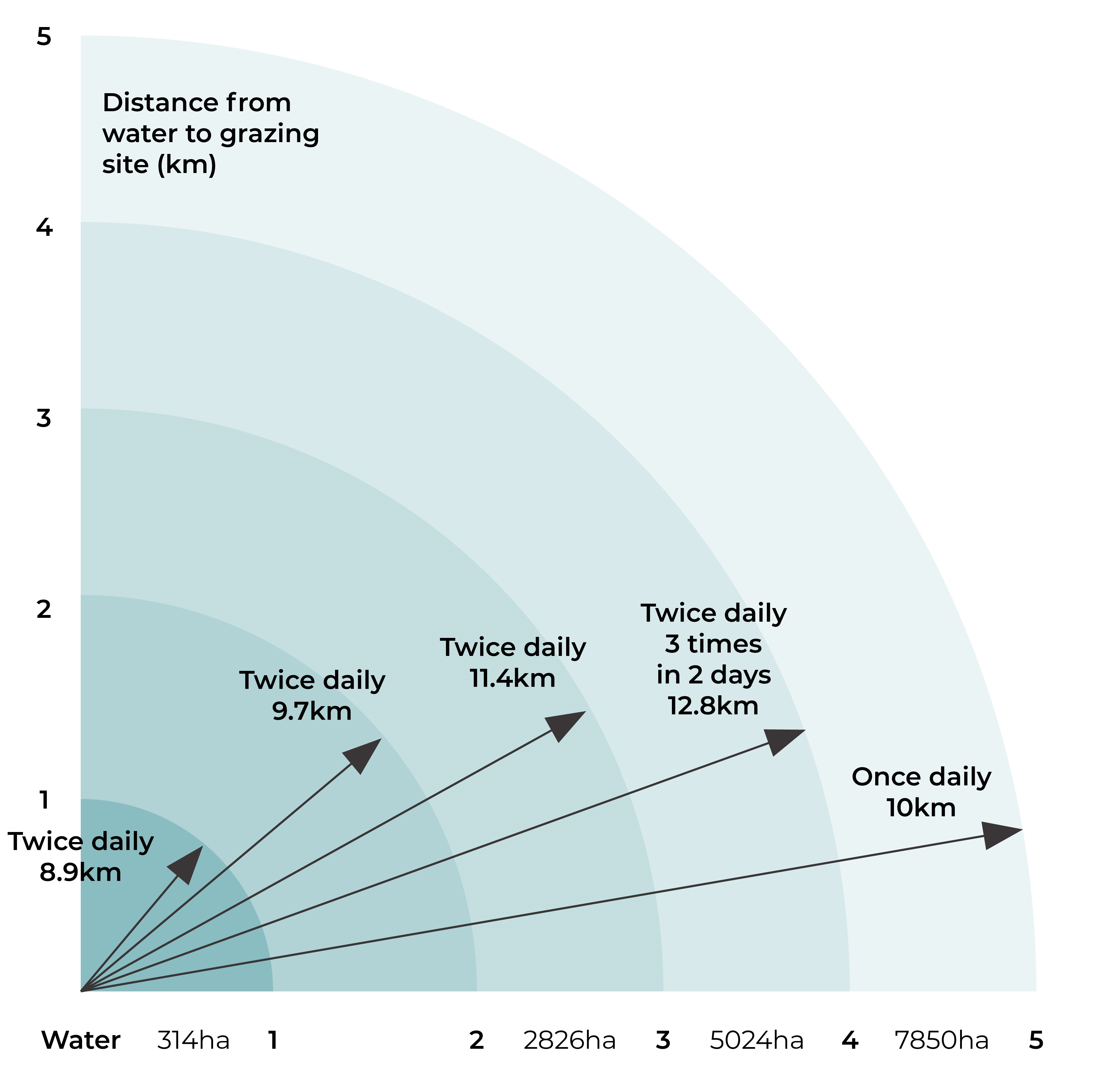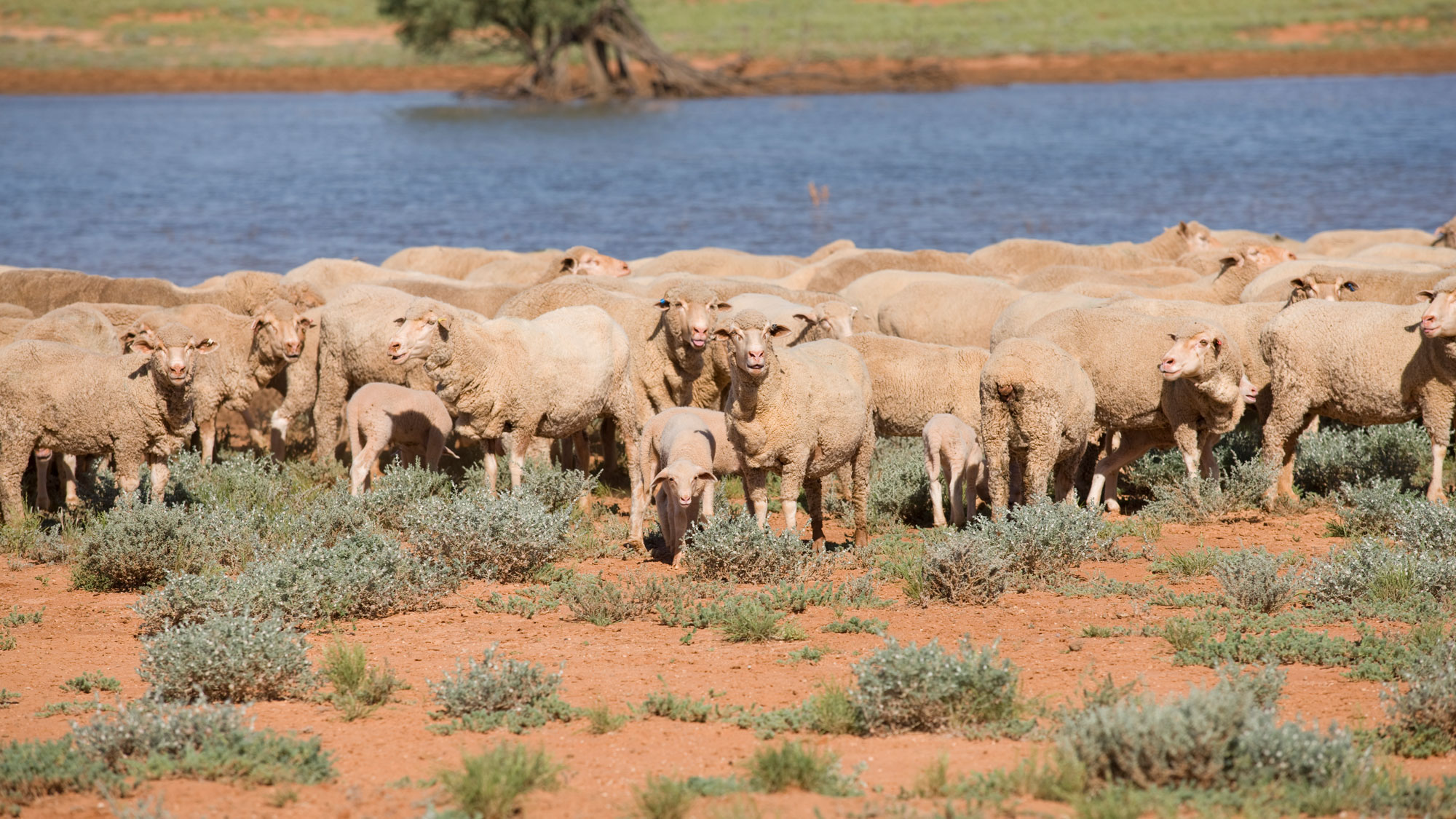Tool 12.3 Conduct a water audit for your property
Tool 12.3 Conduct a water audit for your property
When conducting a water audit for your property you need to consider various aspects of your property that impact on the performance of the business.
Water source
On your map, you will need to list where the watering points and sources are, as well as their condition, and plans for improvement/refurbishment.
Investment in water infrastructure is not a cheap exercise, and can be time consuming, but it is essential to creating an effective grazing management system. There are many sources of water, and many methods of managing this valuable resource:
- Establishing systems for surface water collection in dams;
- The development of bores;
- Managing access to creeks or other natural water sources;
- Increasing on-farm storage capacities;
- Distributing water using poly pipe, tanks and troughs;
- Upgrading existing systems (e.g. upgrading windmills to solar pumps, changing open bore drains to piped reticulation systems, monitoring methods, etc.); and
- Use of telemetry and remote management systems.
Similarly, operating, monitoring and maintaining water systems is an essential and costly part of property management.
A cost that is often less recognised is the penalty cost caused by water issues:
- Limiting the ability of stock to access grazing areas due to water quality or insufficient watering points, or dry dams;
- The quality of the water impacting on reproduction or wool and meat production;
- Inefficiencies as a result of travel times to start pumps, or time taken to repair ageing systems and equipment; and
- Inefficiencies and costs associated with undertaking routine water runs, when this could be partly or entirely replaced in a cost effective manner with remote monitoring systems.
The benefits of having well planned water infrastructure in place are immeasurable. It allows stock to water adequately in times of peak demand, with little strain on stock, or the system.
Undertaking an audit of your farm’s water resources and stock water requirements is an exercise which can provide a high level of value in formulating your strategy for grazing management, as well as managing other limiting factors at critical times (for example, labour and fuel for water runs). Use the opportunity to look into new technologies in water management, such as remote monitoring. The cost saving on labour, fuel and vehicle wear and tear is often offset by establishment of such a system.
Water quality
Water quality can directly impact on livestock performance, and it is important to understand the impact of poor and good water quality. Knowing the quality of your water sources can identify potential problems with livestock performance, and will help avoid unnecessary penalties from water quality issues.
Water testing services are available from private companies and many of the state agriculture departments.
Use one or all of the following components to obtain accurate information about the status of your water supply. This may then feed into your business plan and improvement schedule.
Table 12.3 provides a guide to sheep water intake levels.
Table 12.3 Sheep water requirements.
Source: Meaker et al. 2007
|
Class of sheep |
Consumption per head per day (litres) |
|
Weaners |
2–4 |
|
Adult dry sheep – grasslands |
2–6 |
|
Adult dry sheep – saltbush |
4–12 |
|
Ewes with lambs |
4–10 |
|
Rams |
4–10 |
These intake figures are average figures and can be used on a planning basis to determine the levels of water storage required. Storage allowances also need to allow for:
- Wind ‘droughts’ when windmills may be ineffective and back-up pumping systems are required;
- Seepage and high evaporation rates for surface catchment systems in the summer;
- Lower than ideal in-flow into surface catchment systems due to poor seasonal rainfall; and
- Breakdowns or failures of pumps, and other water related equipment/infrastructure.
Table 12.4 may be used as a general guide for assessing water suitability for livestock and shows the effects of different levels of salinity on each type of livestock.
The measure of salinity in table 12.4 is given as an electrical conductivity (EC) reading in microsiemens per centimetre (μS/cm). The EC value is obtained by dividing the milligrams per litre (mg/L) or parts per million (ppm) value given in the reference literature by 0.64 to give μS/cm. To convert salinity as mg/L or ppm to EC, multiply ppm by 0.64m/L.
Table 12.4 Effects of saline drinking water for various livestock types.
Source: Water for livestock: interpreting water quality tests, 2014, adapted by AWI and MLA
|
Livestock |
No adverse effects on animals expected |
Animals may have initial reluctance to drink or there may be some diarrhoea, but stock should adapt without loss of production |
Loss of production and a decline in animal condition and health would be expected. Stock may tolerate these levels for short periods if introduced gradually. |
|
|
EC in μS/cm |
EC in μS/cm |
EC in μS/cm |
|
Poultry |
0 to 3,100 |
3,100 to 4,700 |
4,700 to 6,300 |
|
Dairy cattle |
0 to 3,900 |
3,900 to 6,300 |
6,300 to 10,900 |
|
Beef cattle |
0 to 6,300 |
6,300 to 7,800 |
7,800 to 15,600 |
|
Horses |
0 to 6,300 |
6,300 to 9,400 |
9,400 to 10,900 |
|
Pigs |
0 to 6,300 |
6,300 to 9,400 |
9,400 to 12,500 |
|
Sheep |
0 to 7,800 |
7,000 to 15,600 |
15,600 to 20,300* |
* Sheep on lush green feed may tolerate salinity up to an EC value of 20,300 μS/cm without loss of condition or production.
The following table provides a guide on the distances walked based on different water salinity levels.
Table 12.5 Impact of water salinity on grazing area of sheep.
Source: Western Australia Department of Agriculture, 2003, adapted by AWI and MLA
|
Water salinity (ppm) |
||||
|
2,500 |
5,000 |
7,500 |
10,000 |
|
|
Non-salty feed |
||||
|
Grazing radius (km) |
4.0 |
3.8 |
3.7 |
3.5 |
|
Grazing area (ha)* |
5,020 |
4,540 |
4,300 |
3,850 |
|
Salty feed |
||||
|
Grazing radius (km) |
3.0 |
2.9 |
2.8 |
2.7 |
|
Grazing area (ha)* |
2,830 |
2,640 |
2,460 |
2,290 |
* Grazing areas indicative only
Sheep grazing on saltbush commonly need to drink twice a day and have a reduced grazing range compared to sheep grazing less salty feed types (e.g. grasslands). Salty diets require additional water to flush the salt load from the sheep’s system (Squires 1981). When the water is saline, there is a significant reduction in the grazing radius and the utilisation of paddock .

Figure 12.8 Distance from water to grazing site (km).
Source: AWI and MLA
Inventory of water sources
|
Name of source |
Source type |
Reliability |
Flow rate/ capacity |
Number of watering points servicing |
Maximum number of stock to water per day |
Maximum daily requirements (L/day) |
Capacity status (good/fair/poor) |
|
|
Big dam |
Dam – northern catchment |
Excellent |
2ML |
5 – via solar pump to troughs in paddocks 1–3 |
5,000 |
50,000L with sheep lactating |
Good – excellent catchment |
|
|
|
|
|
|
|
|
|
|
|
|
|
|
|
|
|
|
|
|
|
|
|
|
|
|
|
|
|
|
|
|
|
|
|
|
|
|
|
|
|
Maximum daily requirements
Remember to calculate the requirements of each class of stock separately as they all require different amounts (for example, lactating stock require more than dry stock). Add up the requirements for each class of stock to calculate your maximum daily requirements.
Consider the requirements at key times of the year, such as summer when stock naturally drink more and when stock are lactating.
It is advisable to use the maximum potential requirements, so so you can plan to ensure that you have ample water at critical times. Water is a resource which you don’t want to underestimate your need for.
|
Class of stock |
Maximum number in mobs |
Maximum daily requirement (L) |
Average daily requirement (L) |
Total amount required per day for mob (peak L) |
Average daily demand for class of stock (L) |
|
Dry breeding ewes |
2,000 |
10 |
6 |
20,000 |
12,000 |
Writing down your maximum mob sizes is useful, as it allows you to compare your peak supply with demand for paddocks or mobs. This may illustrate potential weak points in your water management, and be useful in considering risk management plans or strategies.
Use tool 5.2 from MMFS Module 5 Protect Your Farm’s Natural Assets to prepare a water inventory.






